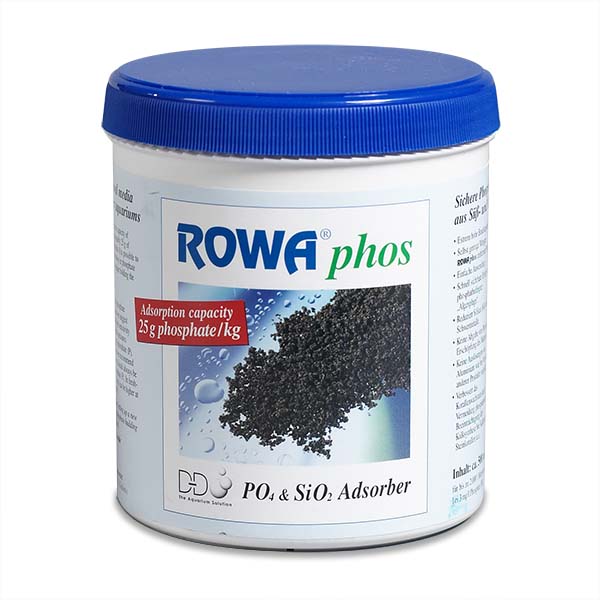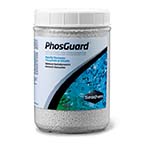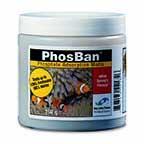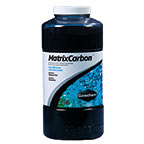Overview
| * | Premium phosphate-removing chemical filter media for aquariums |
| * | Binds phosphate without releasing it back into aquarium water |
| * | Effectively lowers phosphate levels in fresh or saltwater aquariums |
The ultimate phosphate removal media for freshwater and saltwater aquariums. Originally developed in Germany to treat water supply mains, this unique and patented ferric hydroxide media is chemically engineered for efficient removal of phosphate, arsenic, and silicate. Rowaphos binds aquarium pollutants and does not release phosphate back into the water even when exhausted. Increased concentration of the aquarium pollutant phosphate can contribute to unwanted conditions including aggressive nuisance algae growth and inhibition of calcification in such marine organisms as calcareous algae and hard corals. Use Rowaphos to effectively remove phosphate and improve aquarium water quality. The binding (adsorption) capacity of Rowaphos is approximately 25 grams phosphate per kilogram of media.
Suggested Use
| Freshwater | Saltwater | |
| 500 ml | Up to 1,000 gallons | Up to 500 gallons |
Usage
Rowaphos can either be used in a canister filter as a separate slow phosphate filter or can be utilized at the end of the main filter system as the final stage after the biological and mechanical filters. The material can either be used in filter bag or sandwiched between two layers of fine filter pads (on the incoming and outgoing flow).
To reduce the phosphate level in the water column by approximately 3 ppm phosphate measured as (PO4) use:
| Freshwater | Saltwater | |
| 500 ml | Up to 1,000 gallons | Up to 500 gallons |
Note:
The amount of Rowaphos required will be determined by both the level of phosphate in the water column and the level of phosphate in the rock, gravel and other substrate in the aquarium. The above chart is for maintenance use on aquariums where the phosphate level within the substrate has already been reduced. On new or established aquariums where the phosphate levels are high, first measure the level in the water and assume 2-4 times that amount may be bound in the substrate. Adjust the recommended amount (per above chart) by dividing aquarium size by 2-4 times.
The lifetime of the filter material, like the usage, depends entirely on the PO4 concentration in the aquarium. Regular checks with a precise and reliable phosphate test will show the extraordinary effectiveness of Rowaphos. In addition, it will indicate in advance when the filter material is due to be changed.
Rowaphos can work for several months in the aquarium before replacement is required, depending on the initial phosphate concentration and level of feeding. It is important to remember that with an established aquarium that has not used Rowaphos before, phosphate concentrations may be at exceptionally high levels of 5 ppm or more requiring several times the quantity specified above to remove the phosphate from the water column and to eradicate levels absorbed into the substrate and rocks.
Use Rowaphos immediately when setting up a new aquarium. This ensures that no high PO4 concentration can arise in the first place. To eliminate phosphate successfully, it is necessary to use Rowaphos in a new or matured aquarium on a permanent basis.
Note: Do not rinse Rowaphos before use! In some cases the use of Rowaphos can turn the aquarium water slightly brown in color due to the dislocation of finer particles of the material. This is completely harmless for fish or any other organisms and will disappear after a short period of time.
Always replace the lid of the Rowaphos container after use.
Tips on Rowaphos
To obtain the best results from Rowaphos and to keep your aquarium at zero phosphate levels, it is important to use Rowaphos at the startup of a new fresh or saltwater aquarium. Phosphate is released from both gravel substrates and live-rock. Therefore, it is very important at the early stage of the aquarium to remove the phosphate immediately to reduce potential nuisance algae blooms.
Rowaphos will adsorb phosphate, silicate, and arsenic and is entirely safe in both fresh and saltwater systems. It does not release any of the absorbed materials back into the aquarium even when fully loaded.
Rowaphos only needs replacing when the phosphate levels in the aquarium or at the outlet from the canister filter start climbing. This indicates that the Rowaphos have absorbed phosphate to its full holding capacity.
During use of Rowaphos, you will see no ill effects. Additionally, if you are using Rowaphos in a saltwater invertebrate aquarium, hard and soft corals may grow up to approximately three times as fast when phosphate levels are below 0.015 ppm.
- Never wash Rowaphos for non-fluidized use.
- Rowaphos must be kept damp at all times as its effectiveness is significantly reduced if allowed to dry out. Always replace the lid if not using the entire container.
- The media can be used in a mesh filter media bag or sandwiched between two layers of mechanical filter media in a canister filter.
- Do not sprinkle Rowaphos directly into the aquarium.
- Never place Rowaphos directly into water without first surrounding it with sponge or floss.
- When used in a canister filter, the flow should be adjusted until zero phosphate level is achieved.
- It is important that the filter media bag is clean at all times. Otherwise, water will not flow through the Rowaphos media inside.
- Use of larger quantities of Rowaphos may temporary lower the pH within the aquarium.
Phosphate Levels and Testing In marine systems, phosphate levels should always be maintain below 0.015 ppm (when measured as phosphorous 'P', 0.046 when measured as phosphate ion 'PO4-'. In freshwater systems and ponds, phosphate levels should be less than 0.03 ppm 'P' and 0.092 ppm 'PO4-').
Fluidizing Rowaphos
For simplicity of use and to maximize the life of the media, it is recommended to fluidize Rowaphos in a fluidized chemical media reactor. This method makes the entire media surface area available for adsorption from the water stream. Important: Take care not to over fluidize the media. When fluidizing Rowaphos, it is recommended to flush the media through in the chemical media reactor with fresh or reverse osmosis water to remove any fine particles that would otherwise temporarily discolor the aquarium. The fine particles are not harmful but may be seen by some as unsightly if it settles on the base of the aquarium or on rocks (Please note: This advice is contrary to that given for normal use in a media bag or canister filter where it is recommended that Rowaphos is used unwashed).
To Flush the Media:
First place the media in the fluidized chemical media reactor and connect the reactor to a freshwater supply. Slowly feed water through the unit being careful not to over fluidize the Rowaphos. Discard the brown water that first exits the reactor. When the water starts to clear, switch off the water supply and carefully tip the reactor to remove any excess freshwater above the media. Connect the chemical media reactor to a pump and carefully turn on the pump. Adjust the flow rate until the surface of the Rowaphos just starts to move. Any remaining discoloration of the water will quickly disappear.
General Information
Rowaphos is a completely new filter material for eliminating phosphate. Due to its unique chemistry, it has an outstanding ability to bind large quantities of phosphate by absorption to its surface without negatively influencing the water in the aquarium in any way.
Phosphate (PO4) in the aquarium is caused by the decomposition of organic substances. In the confined habitat of an aquarium, several of these decomposition processes take place on surplus food, dead plant and animal matter, animal waste, etc.
Phosphate is an important component of life, which is harmless only in low concentrations. Natural waters that have not yet been polluted by human intervention show very low PO4 concentration. However, it is nearly impossible to maintain this ideal condition in an aquarium without artificial aid.
An increase in concentration leads to unwanted conditions including aggressive nuisance algae growth and to the inhibition of calcification in certain specialized marine organisms, such as calcareous algae and hard coral. To remedy these phosphate-induced conditions, it is recommended to always keep the concentration of phosphate at or below 0.1-0.3 ppm in freshwater systems and in saltwater systems, it should always be kept below 0.015 ppm.
This target level can be easily achieved with Rowaphos. This highly active filter material can be used in freshwater as well as saltwater systems. Rowaphos binds PO4 without negatively influencing aquarium water. When exhausted, Rowaphos does not release phosphate back into the water. Rowaphos can and should be used in aquaria with sensitive fish such as Discus or in marine aquariums with complex organisms.













